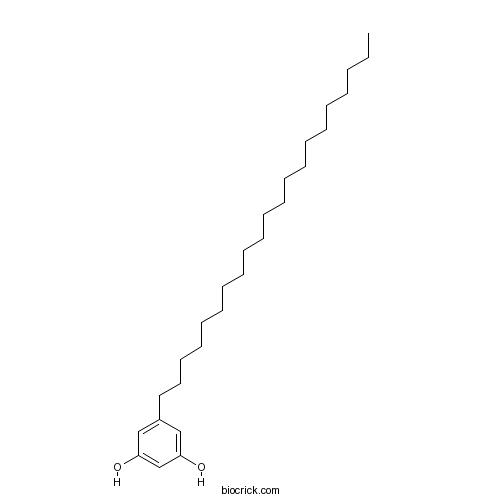5-HeneicosylresorcinolCAS# 70110-59-7 |

Quality Control & MSDS
3D structure
Package In Stock
Number of papers citing our products

| Cas No. | 70110-59-7 | SDF | Download SDF |
| PubChem ID | 155461 | Appearance | Powder |
| Formula | C27H48O2 | M.Wt | 404.66 |
| Type of Compound | Phenols | Storage | Desiccate at -20°C |
| Solubility | Soluble in Chloroform,Dichloromethane,Ethyl Acetate,DMSO,Acetone,etc. | ||
| Chemical Name | 5-henicosylbenzene-1,3-diol | ||
| SMILES | CCCCCCCCCCCCCCCCCCCCCC1=CC(=CC(=C1)O)O | ||
| Standard InChIKey | BLHLKJLSYHEOGY-UHFFFAOYSA-N | ||
| Standard InChI | InChI=1S/C27H48O2/c1-2-3-4-5-6-7-8-9-10-11-12-13-14-15-16-17-18-19-20-21-25-22-26(28)24-27(29)23-25/h22-24,28-29H,2-21H2,1H3 | ||
| General tips | For obtaining a higher solubility , please warm the tube at 37 ℃ and shake it in the ultrasonic bath for a while.Stock solution can be stored below -20℃ for several months. We recommend that you prepare and use the solution on the same day. However, if the test schedule requires, the stock solutions can be prepared in advance, and the stock solution must be sealed and stored below -20℃. In general, the stock solution can be kept for several months. Before use, we recommend that you leave the vial at room temperature for at least an hour before opening it. |
||
| About Packaging | 1. The packaging of the product may be reversed during transportation, cause the high purity compounds to adhere to the neck or cap of the vial.Take the vail out of its packaging and shake gently until the compounds fall to the bottom of the vial. 2. For liquid products, please centrifuge at 500xg to gather the liquid to the bottom of the vial. 3. Try to avoid loss or contamination during the experiment. |
||
| Shipping Condition | Packaging according to customer requirements(5mg, 10mg, 20mg and more). Ship via FedEx, DHL, UPS, EMS or other couriers with RT, or blue ice upon request. | ||
| Description | 1. 5-Heneicosylresorcinol shows inhibitory effects on the release of β-hexosaminidase from RBL-2H3 cells. 2. 5-Heneicosylresorcinol prevents triglyceride accumulation in 3T3-L1 cells. 3. 5-Heneicosylresorcinol has nematicidal activity against nematodes Panagrellus redivivus, Caenothabditis elegans and Bursaphelenchus xylophilus, with ED50 values of 80, 30, and 180 ug/mL, respectively. |
| Targets | Antifection | NADPH-oxidase |

5-Heneicosylresorcinol Dilution Calculator

5-Heneicosylresorcinol Molarity Calculator
| 1 mg | 5 mg | 10 mg | 20 mg | 25 mg | |
| 1 mM | 2.4712 mL | 12.3561 mL | 24.7121 mL | 49.4242 mL | 61.7803 mL |
| 5 mM | 0.4942 mL | 2.4712 mL | 4.9424 mL | 9.8848 mL | 12.3561 mL |
| 10 mM | 0.2471 mL | 1.2356 mL | 2.4712 mL | 4.9424 mL | 6.178 mL |
| 50 mM | 0.0494 mL | 0.2471 mL | 0.4942 mL | 0.9885 mL | 1.2356 mL |
| 100 mM | 0.0247 mL | 0.1236 mL | 0.2471 mL | 0.4942 mL | 0.6178 mL |
| * Note: If you are in the process of experiment, it's necessary to make the dilution ratios of the samples. The dilution data above is only for reference. Normally, it's can get a better solubility within lower of Concentrations. | |||||

Calcutta University

University of Minnesota

University of Maryland School of Medicine

University of Illinois at Chicago

The Ohio State University

University of Zurich

Harvard University

Colorado State University

Auburn University

Yale University

Worcester Polytechnic Institute

Washington State University

Stanford University

University of Leipzig

Universidade da Beira Interior

The Institute of Cancer Research

Heidelberg University

University of Amsterdam

University of Auckland

TsingHua University

The University of Michigan

Miami University

DRURY University

Jilin University

Fudan University

Wuhan University

Sun Yat-sen University

Universite de Paris

Deemed University

Auckland University

The University of Tokyo

Korea University
- TCN 237 dihydrochloride
Catalog No.:BCC6111
CAS No.:700878-19-9
- LY2157299
Catalog No.:BCC3709
CAS No.:700874-72-2
- LY2109761
Catalog No.:BCC3806
CAS No.:700874-71-1
- Acronycine
Catalog No.:BCC8114
CAS No.:7008-42-6
- 4,10-Aromadendranediol
Catalog No.:BCN4261
CAS No.:70051-38-6
- LPYFD-NH2
Catalog No.:BCC6113
CAS No.:700361-48-4
- Rivularin
Catalog No.:BCN3189
CAS No.:70028-59-0
- Terazosin HCl
Catalog No.:BCC4354
CAS No.:70024-40-7
- 2-Adamantanone
Catalog No.:BCN8473
CAS No.:700-58-3
- 2-Adamantanol
Catalog No.:BCN8479
CAS No.:700-57-2
- Indole-3-carbinol
Catalog No.:BCC5318
CAS No.:700-06-1
- H-Tyr(3-I)-OH
Catalog No.:BCC3265
CAS No.:70-78-0
- 5-Tricosyl-1,3-benzenediol
Catalog No.:BCN4262
CAS No.:70110-60-0
- 5-Pentacosylresorcinol
Catalog No.:BCN4263
CAS No.:70110-61-1
- BMS-626529
Catalog No.:BCC1427
CAS No.:701213-36-7
- DGAT-1 inhibitor
Catalog No.:BCC1529
CAS No.:701232-20-4
- Talopram hydrochloride
Catalog No.:BCC7579
CAS No.:7013-41-4
- Liquiritic acid
Catalog No.:BCN8332
CAS No.:10379-72-3
- Isotetrandrine N-2'-oxide
Catalog No.:BCN4264
CAS No.:70191-83-2
- Papain Inhibitor
Catalog No.:BCC1024
CAS No.:70195-20-9
- Taranabant
Catalog No.:BCC1985
CAS No.:701977-09-5
- 3-Aminoadamantan-1-ol
Catalog No.:BCC8618
CAS No.:702-82-9
- 8alpha-Hydroxy-alpha-gurjunene
Catalog No.:BCN4265
CAS No.:70206-70-1
- (±)-Lauroylcarnitine chloride
Catalog No.:BCC6690
CAS No.:7023-03-2
Inhibitory effect of natural phenolic lipids upon NAD-dependent dehydrogenases and on triglyceride accumulation in 3T3-L1 cells in culture.[Pubmed:14733503]
J Agric Food Chem. 2004 Jan 28;52(2):246-50.
Alkylresorcinols are phenolic lipids present at levels of 0.03-0.15% in wheat and rye grains and almost 10 times higher in respective bran products. Despite numerous studies on the influence of dietary fibers on the regulation of energy metabolism, this issue still remains controversial. The objective of our current studies was to investigate whether 5-n-alk(en)ylresorcinols, natural phenolic components of high fiber human diets, may be considered as natural regulators of excessive fat accumulation. Our studies revealed that 5-n-alk(en)ylresorcinols isolated from wheat and rye bran inhibit glycerol-3-phosphate dehydrogenase, the key enzyme in triglyceride synthesis in adipocytes, specifically and effectively. Further in vitro studies showed that these compounds also prevent triglyceride accumulation in 3T3-L1 cells. The most effective compound in both systems was 5-n-heneicosylresorcinol. The results indicate that the potential to prevent triglyceride accumulation increases with the hydrophobicity of the phenolic inhibitor.


